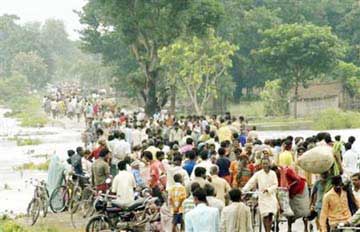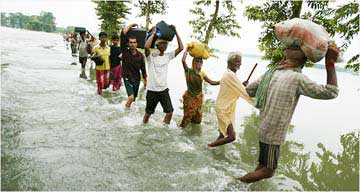
Archive 2009
|
September 16-30, 2008
Kosi devastates Bihar: Government is responsible for this tragedy of gigantic proportions
Over 30 lakh people in 16 districts have been devastated. Homes, cattle and belongings have been completely swallowed up. Hundreds of people have gone missing. There are no official death toll figures. However, tens of thousands are feared dead. According to the authorities, the flood has affected over 850 villages. The Indian state is responsible for the Kosi river breaching its embankment, as well as its subsequent change of course. It is responsible for the terrible human tragedy that has followed. It has compounded its crimes through the callous “rescue and relief measures”. These taken as a whole, constitute a glaring indictment of the thoroughly anti-people character of the Indian state and the reactionary bourgeoisie ruling our country.
People left to fend for themselves It took more than a week after the flood waters had begun submerging entire villages, for any kind of serious relief operations to commence. The government’s rescue and relief operations have been woefully inadequate. Only the armed forces are trained for rescue operations on such a massive scale. Their deployment has been totally inadequate. The rescue efforts have been severely crippled by lack of supplies such as boats and other equipment. With just a few hundred boats deployed for rescue operations, nearly 25 lakh people are marooned. People have been forced to use make-shift rafts to move their families to temporary safety. Boats have capsized at Supaul and Madhepura, leading to many deaths. In the relief camps organised by the government, people are facing inhuman conditions. Relief workers have reported acute shortage of food and relief materials. There are not even enough polythene sheets to offer meagre protection from the pelting rain. Food packets dropped from helicopters have been completely inadequate. Many people have died of starvation. Food riots have broken out. Government godowns have been ransacked. Extortion, looting and rampant corruption is the order of the day. Health workers heroically trying to treat the wounded and sick, have complained that medical supplies are very inadequate. Many have died at the relief camps and the threat of epidemic is looming large. The relief camps are also getting flooded. Masses of people are moving towards the relief camps which are still unaffected by the floods. Women, children and the aged are forced to walk many kilometres with their meagre belongings on their heads, to save themselves. There are indications that victims would have to stay in relief camps till March and April, 2009, because there is little possibility of the water receding before that. In contrast with the callousness of the government, residents of nearby villages, which fall within the normal course of the river and who therefore anticipate floods at this time but have remained dry, have rushed in their stocks of foodgrains and other items, to help the flood affected villagers. Tragedy was avoidable There is no reason why such large scale human tragedies can not be prevented, and even if they occur, their effects minimized, given the present level of scientific-technical development of our country. The Kosi is a river which regularly floods its banks almost every year. It is also a young river which has changed its course several times, mostly westwards, during the past 250 years. The breach in the barrage and the possibility of the Kosi changing its course were predictable. Under the 1954 agreement between the governments of Nepal and India, the eastern embankment was built in 1959. About 59 km of this embankment lies within Nepal, while 211 km lies in Bihar. It is supposed to be repaired and maintained by the Bihar government’s water resources department, with funds granted by New Delhi. People have pointed out that government has neglected repair and maintenance work on the embankment, using the “law and order situation in Nepal” as an excuse. The last major repair and maintenance work took place eighteen years ago. In fact, before the current floods, several experts had pointed out that the embankment was already weakened in at least two places, due to lack of repair. But Bihar’s water resources department had declared all the embankments under its supervision as ‘safe’ just two days before the Kosi breached its embankment. Much of the funds allocated for this work appear to have been instead used for building bungalows and rest houses for government officials in the region. Ostensibly built for providing accommodation to the officials assigned with the task of maintaining vigil on the barrage and embankment, these rest houses are reported to be serving more as “recreation” resorts for various VIPs of the state. Enraged local residents declared that they had observed the river water fiercely impounding the embankment since August 5-6 and reported this to the concerned officials. However, these officials took no action. On August 18, when the river breached the embankment, there was not a single official to be seen on the Indian side of the border. According to the people, the embankment would not have given way like this, if it had been properly repaired and maintained on time. A comprehensive, scientific approach, putting the well being of people of the riparian area at the center, is necessary for managing these rivers. As this river originates in Nepal, there is need for an arrangement between the two countries which is of mutual benefit. Need for People’s Power Most important is the question of who wields political power and whose interests the state serves. Political power must be in the hands of the people, so as to guarantee the people’s safety and security. Political power cannot and must not continue to remain in the hands of a privileged minority, as is the case today. Only people’s power, the rule of the working class and toiling people will create the conditions for ensuring that science and technology, together with the traditional wisdom of the people, are used for harnessing our resources and the forces of nature in the best interests of the whole of society. Human tragedies such as these will then truly be a thing of the past. |


